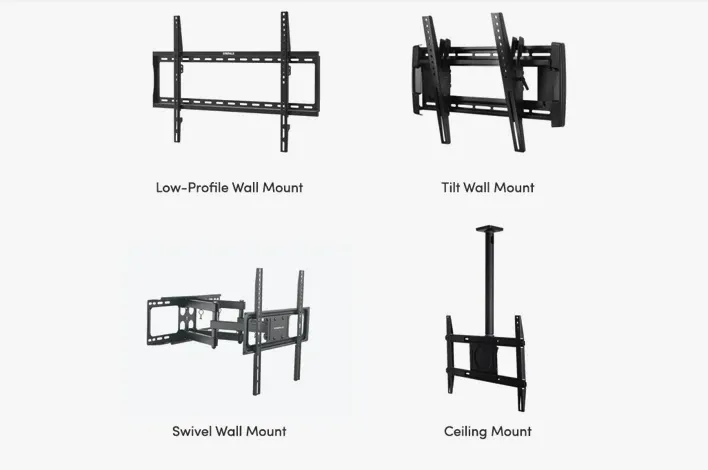
How to Choose Between Fixed, Tilting, and Full-Motion TV Mounts
How to Choose Between Flat Mount, Tilt Mount, Full-Motion, or Ceiling Mount for Your TV
Mounting your TV on the wall is an excellent way to save space and create a sleek, modern look. But with different types of TV mounts available—flat, tilting, full-motion, and ceiling mounts—it can be difficult to know which one is right for your home. In this post, we’ll break down the pros and cons of each type of TV mount to help you make the best choice for your space and viewing preferences.
Flat/Fixed TV Mount: Simple and Sleek
A flat (or fixed) TV mount is one of the most popular options. It holds your TV snug against the wall, giving it a minimalist appearance without any movement options.
Advantages of Flat TV Mounts:
Slim Profile: A flat mount keeps the TV as close to the wall as possible, often less than an inch of space.
Cost-Effective: Flat mounts tend to be more affordable compared to tilting or full-motion mounts.
Sturdy and Secure: Since the TV doesn’t move, there are fewer parts that could wear down over time.
Disadvantages of Flat TV Mounts:
Limited Viewing Angle: Flat mounts don’t allow for any adjustment, so you need to ensure your TV is mounted at the correct height and location for comfortable viewing.
Access to Ports: If your TV’s ports are on the back, a flat mount can make it difficult to access them after installation.

Receive A Free TV Mounting Estimate
Tilt TV Mount: Adjust for Comfort
A tilting TV mount allows the TV to tilt up or down. This is useful for reducing glare or adjusting the viewing angle when the TV is mounted higher on the wall.
Advantages of Tilt TV Mounts:
Glare Reduction: If your room has windows or other light sources, a tilting mount allows you to angle the TV to avoid reflections.
Better Viewing for Higher Mounts: If you mount your TV higher on the wall—like over a fireplace—a tilting mount lets you angle it down for more comfortable viewing.
Disadvantages of Tilt TV Mounts:
Limited Range of Motion: While it offers vertical movement, a tilt mount doesn’t allow side-to-side motion.
Slightly Bulkier: Tilt mounts add a little more space between the TV and the wall than flat mounts.

Full-Motion TV Mount: Maximum Flexibility
A full-motion TV mount (also called an articulating or swivel mount) offers the most flexibility, allowing you to tilt, swivel, and extend your TV away from the wall. This is great for rooms with multiple viewing areas or awkward spaces.
Advantages of Full-Motion TV Mounts:
Versatile Viewing Angles: You can adjust the TV to face different seating areas or reduce glare, offering a more comfortable viewing experience from any spot in the room.
Extend and Retract: Full-motion mounts allow you to pull the TV away from the wall and rotate it, which is useful in large or open-plan rooms.
Disadvantages of Full-Motion TV Mounts:
More Expensive: Full-motion mounts are generally more expensive than flat or tilting mounts due to their flexibility and complexity.
Bulkier: The arm mechanism takes up more space, so your TV will sit further from the wall, even when retracted.

Ceiling TV Mount: Great for Special Spaces
A ceiling mount is an option for those who want to suspend their TV from the ceiling. This type of mount is often used in commercial spaces or rooms with limited wall space.
Advantages of Ceiling TV Mounts:
Space-Saving: In rooms where wall space is limited or in awkward layouts, a ceiling mount can free up room.
Full Rotation: Many ceiling mounts allow the TV to rotate 360 degrees, giving maximum flexibility in where the TV is positioned.
Disadvantages of Ceiling TV Mounts:
Complex Installation: Installing a ceiling mount can be more challenging than wall mounts and may require professional help.
Less Aesthetic Appeal: Some people may not like the look of a TV hanging from the ceiling, especially in residential settings.

How to Choose the Right Mount for Your TV
When deciding which mount to choose, consider the following factors:
Room Layout and Viewing Angle
If your TV is directly in front of your seating area and you don’t need to adjust the angle, a flat mount may be the best option.
For TVs mounted higher or in a room with glare issues, a tilt mount can improve comfort.
If you need flexibility, such as viewing the TV from different angles or locations, a full-motion mount offers the most options.
Wall Type
Ensure your wall can support the type of mount you choose, especially for full-motion or ceiling mounts, which require stronger support.
TV Size and Weight
Make sure the mount is compatible with the size and weight of your TV. Larger TVs may require more robust mounts, particularly for full-motion models.
[Image Placement: Add a visual comparison chart of different mount types, TV sizes, and compatibility.]
Conclusion
Choosing the right TV mount depends on your room setup, viewing habits, and personal preferences. A flat mount offers a sleek, minimalist look, while a tilt mount provides better angles for higher placements. For maximum flexibility, a full-motion mount is ideal, and in certain cases, a ceiling mount can be a space-saving solution. Whatever you choose, make sure the mount fits your TV and is installed securely for the best viewing experience.
Call to Action
Need help choosing or installing the perfect TV mount for your home? Contact us today for professional advice and installation services!